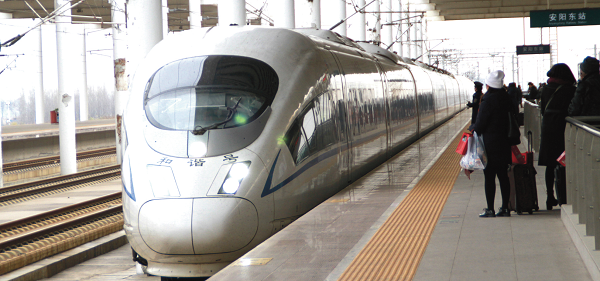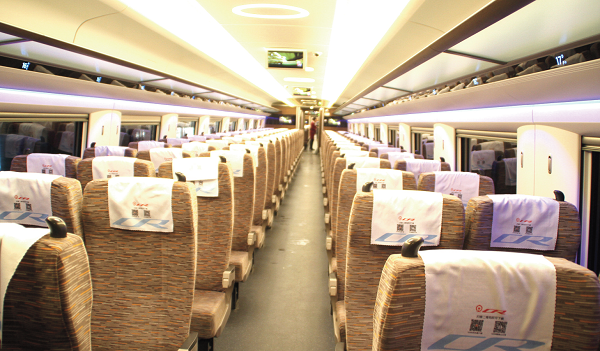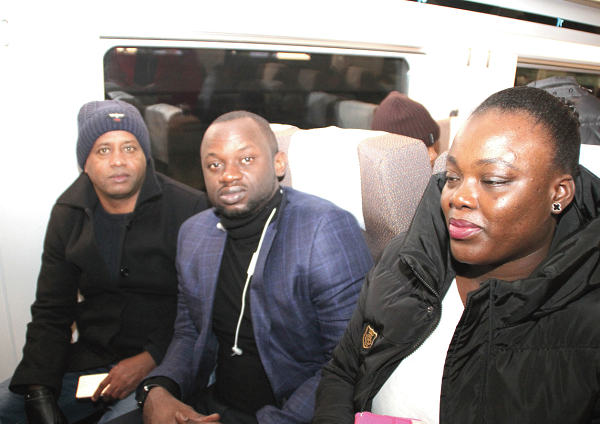
Catching up with the world’s fastest train
To avoid the intense traffic and make it on time for that crucial meeting scheduled to start in 45 minutes we all decided to park our cars and move to the venue by train.
A train arrived and left for the centre of town every 15 minutes at all the various stops and train stations, and so although we all lived far apart in different parts of the city, we all expected to meet in the office 10 minutes before time.
Advertisement

The sleek speed train before it started the journey to Shanghai
But just as I got on board the train to enjoy a stress-free ride to the office, I was awoken from wonderland to reality by the deafening honking of an infuriated driver behind me – I had been daydreaming while stuck in traffic for several minutes.
Who will not always relish a fantasy yet never had true experience of a smooth ride aboard a bullet train even if that occurrence was only once? Getting on board the sleek and slithering cosy train numbered five (G5) that fateful morning was, however, not my first experience of the world of fast trains, especially in China which has also developed a driverless train service.
The excitement stemmed from the fact that it was the fastest of all the bullet or speed trains I had ever travelled on. Moreover, I was one of the privileged few to travel as a VIP on the train from the Chinese capital, Beijing, to the famed Manhattan of China – Shanghai.
On Monday, November 20, 2017, the day a team of African journalists in China on a 10-month exchange programme courtesy the China Public Diplomacy Association (CPDA) and the China Africa Press Centre (CAPC) eagerly awaited, finally arrived.
We all yearned to visit Shanghai before the programme ended in December and on that morning we were driven to the Beijing South Railway Station, which was opened in 2008 before the Olympic Games, to commence our journey.
Before the start of our journey at about 7:30a.m., however, we were ushered into the VIP lounge of the terminal station put up for trains going to Tianjin and Shanghai, for a short briefing.
Speaking to the journalists, the Deputy Director, International Department, China Academy of Railway Sciences, Mr Zhao Zhangshan, said: “The Beijing to Shanghai train was opened to traffic in 2011 and runs for 1,318 km and connects two of the largest stations in China, Beijing, the capital and economic centre, Shanghai. The rail also goes through the most populated and developed areas in China in the eastern coast area.”

The interior of one of the coaches of the Beijing-Shanghai speed train
High speed trains
We were on board the latest generation of China’s high speed trains, the Fuxin High Speed Train, which was put into service just last year, 2017. These are the fastest trains in the world and run at 350km/hr.
“From Beijing to Shanghai which is 1,018km, it takes only four hours and 28 minutes, at an average speed of almost 300km/hr,”Mr Zhao said.
“In the past 10 years since 2008, China has opened almost 22,000 km of high speed lines starting from the first high speed line from Beijing to Tianjin and in the next 10 years until 2030, we will build another 15,000 km of high speed lines.
“And here in China we have very strong ability of building high speed lines both in engineering and technology,” he added.
He indicated that although China had very challenging geological conditions from the north to the south, it still built high speed lines in the very cold areas up north and also in the hot and tropical areas in the southern islands.
Most of the infrastructure is on thespeed of 350 km/hr and all such lines run at 300 km/hr but advanced their speed to 350 km/hr in 2017. The high speed system is also very safe, he gave the assurance.
Mr Zhao said: “In the past 10 years we carried seven billion passengers on the high speed lines without any accident and according to the statistics of the International Union of Railway, this is the safest high speed system in the world.”
He stated that China’s railway system did not only boast of the pace of construction but also the convenience, comfort and quality of the trains. “Later you can make a test on the train – you can put up a coin at the window to verify how smooth the train runs,” he dared.

Some members of the African team on board the train to Shanghai
According to Mr Zhao, the cost efficiency of the high speed system was very high and came with very low investment and short construction.
“To develop high speed system is the trend in the world, which is environmentally friendly and is a very green transportation system, which is very popular, both in China and many other European countries, which is why many other countries have plans of developing high speed rail,” he stated.
Mr Zhoa said the technology system in China was compatible with standards in both Asia and Europe, and a Chinese company was helping to build a high speed line with the same standard and with a speed of 350 km in Indonesia.
Ghana’s Railway Master Plan
But unlike China which has a very well developed rail (subway) system that has been improved tremendously over the past 30 years, Ghana’s railway started in 1898 under the Gold Coast Civil Service is still struggling for recognition in the country’s transportation sector.
From a very promising 953 km ‘A’- shaped network that had three components - a "Western Division" from Sekondi/Takoradi to Kumasi (280 km), an "Eastern Division" from Accra to Kumasi, and a "Central Division" from Huni Valley to Kotoku, not much is left of the network that included branch lines on the west to Prestea and Awaso, a branch line to Kade on the central portion and branch lines to Tema and Shai Hills on the east.
There however, seems to be light at the end of the long tunnel with the creation of a Ministry of Railways Development to see to the fast development of the railway sector. Whether it will be maintained or scrapped by subsequent governments though is yet to be seen.
On August 3, 2017, the Chief Executive of the Ghana Railways Development Authority, Richard Dombo, said at a consultative stakeholder meeting in Accra that the government had initiated the construction of an 84 km railway line at a cost of $388 million from Tema to Akosombo from October 2017.
The Sector Minister, Mr Joe Ghartey, in a speech read on his behalf by his deputy, Mr Andy Appiah Kubi, on Wednesday, December 6, 2017, also said that the Ghana railway master plan, which envisaged that total rail network would be standard gauge and executed in six phases and remained a guide for the fulfilment of his ministry’s mandate, had proposed a new railway network of 4,007km with an investment of approximately US$21,507,920.

The government is poised to revive rail transport in Ghana
Later in the month, the Ministry of Railway Development announced plans to review the US$ 21.5 billion railway master plan spanning 30 years, which was developed in 2013 because it was not ambitious enough.
That same year, on December 17, the Ghana Railways Company Ltd was able to rehabilitate the western line up to Tarkwa with a plan to completely rehabilitate the line from Accra to Tema in the first quarter of 2018.
The following day on December 18,Ghana hosted the Burkinabe Transport Minister, Souleymane Soulama, who was in the country to negotiate the process to construct a rail line from Accra to Ouagadougou, the Burkina Faso capital.
The project is expected to start from the Tema Port through Paga to Ouagadougou.
Accra- Ouagadougou railway interconnectivity project Following that initial meeting, the technical team from Ghana which forms part of the Joint Experts Committee on the Railway Interconnectivity Project between Ghana and Burkina-Faso, held its preparatory meeting at the Ministry of Railways Development on Tuesday, January 9, 2018.

The Western line up to Tarkwa rehabilitated
Discussions at the meeting included a strategy for the mobilisation of resources for implementation, agreement on the procedure for the appointment of a common contractor for the project and a financial model for the project.
While the international rail project is laudable, it is important to state that Ghana needs to properly develop its local rail sector very well for rail transport to become the preferred mode of transportation among the citizenry as pertains in other countries, before attention is turned to linking the country up with other countries in the sub-region and even beyond.
Writer’s email:
[email protected]



